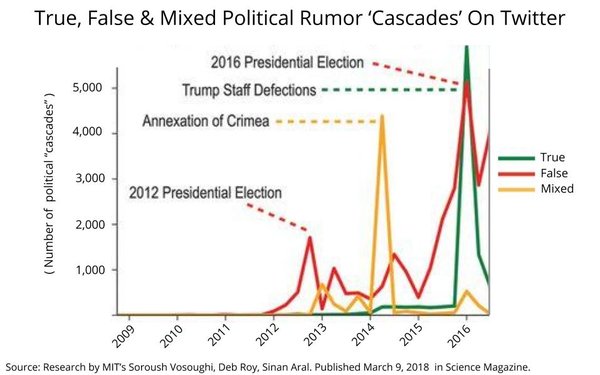Of the many harms that affect the political, economic, and social well-being, the most out-of-line practice is that of spreading false news. Littered with fake news, how exactly social media’s active users plug away at the potential fake news? According to a new study from the University of Buffalo, nearly 90% of ‘active’ Twitter users spread misinformation, especially during public emergencies or disasters. The stats are revealed from a study wherein 20,000 tweets were scrutinized.
The Twitter Fishing Expedition:
The study which attains a place in the journal, Natural Hazards, examines four major false rumours; two from the marathon and two from hurricane, which also includes the infamous fabrication about the New York Exchange Flooding. The study reveals how most people on Twitter tend to mushroom up the fake news by retweeting or simply liking the original post without looking into the actual facts.
Researchers size up the survey and claim three types of behavioural patterns. Twitter users could either spread the false news, seek to confirm it, or cast doubt upon it. Researchers found:
- 86 to 91 percent of the users resort to upping the reach of fake news, either by retweeting or “liking” the original post.
- 5 to 9 percent pursue towards confirming the falsehood, more often than not by retweeting and requesting for the authenticity of the data.
- 1 to 9 percent were sceptic, claim that the original tweet was not accurate.
Even after the falsity of such news was brought to light on Twitter, the study found that:
- Less than 10 percent of the users deleted their false retweet.
- Less than 20 percent of the same users, pressingly, tried to clarify their false retweets with new tweets.
Surprisingly, a huge 78-97 percent of active Twitter users neither deleting nor clarifying the false tweet.
Lies Spread Faster Than The Truth
A few days back we reported regarding the potential false news was conducted earlier wherein the degree to which a false news can spread was put under scrutiny. Soroush Vosoughi et alia, using a basic array of rumour cascades, scrutinized the spread of fake news on Twitter, from the year 2006 to 2017. The MIT group geared up to analyze the tweets through six fact-checking websites, which included Politifact and Snopes, and put an edge on the determination of the validity by a 95 percent agreement among these sources. As per the study, the revelations were:
- False news on Twitter is 70% more likely to be re-tweeted than the real news stories.
- Approximately 3 million people were able to mushroom about 126,000 rumours.
- The top 1 percent fake news cascade circulates among 1000 and 100,000 people.
- The truth surfaces to, about, merely more than 1000 people.
- As per the survey, the degree of novelty and emotional quotient of people are responsible for this change.
- Albeit, often blaming bots and automation for spreading fake news, the researchers took from left field to substantiate the involvement of scientific know-how. Upon removing bots from the analysis by employing an algorithm, they found that people tend to spread novel information; repercussion being that they tweet erroneous news which appears new to them.
A Crowning Blow For Fake News On Twitter?
According to Jun Zhuang, the findings reveal how easily people are vulnerable to misapprehensions and the key role social media plays in these situations. Although, here lies the positive fact that this study also reveals that Twitter users move quickly to correct this erroneous tweets as well.
Furthermore, Zhuang adds up that the study doesn’t encompass the Twitter users who may decide that the tweets are inaccurate and in response chose not to react at all. The group couldn’t determine the number of users who didn’t interact at all since the study only surveyed for tweets, retweets and comments.


